In local baseball news…
The Royals have rebounded from the losing streak and are back to .500 ball. Thank goodness. Below, in their Monarchs uniforms for MLB’s Salute to the Negro Leagues last Sunday, Royals players gleefully await Carlos Santana after his walk-off homer.

Across the state line in Kansas, another team is wearing Monarchs jerseys. The team formerly known as the T-Bones has a new owner (Mark Brandmeyer) and a new name, the Kansas City Monarchs. The team missed last season because of Covid, but the 2021 season opened last week. Rita and I were there with other members of the Monarchs Club, a booster organization for the Negro Leagues Baseball Museum. NLBM President Bob Kendrick was on hand to give the team a locker room talk (click here) and throw out a ceremonial first pitch.

The stadium, near the NASCAR speedway, has also been renamed – Legends Field, a dual nod to the surrounding commercial area (the Legends) and the Field of Legends, the baseball field of statues of Negro League greats at the NLBM. On opening night, as the color guard headed to the field for the Star Spangled Banner, a rainbow appeared at the stadium.

It was a treat to see so many fans wearing vintage Monarchs gear. Have a great season Kansas City Monarchs! Royals too!
Willie Mays Birthday Update: To celebrate his 90th birthday (May 6), Willie Mays circled Oracle Field in San Francisco in a classic 1956 Oldsmobile convertible (video here, with the “Say Hey” song playing; 1:00).
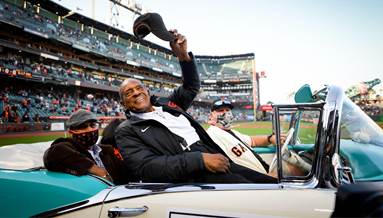
One of the best pieces I saw about Willie’s birthday was a video narrated by Danny Glover and written by Tom Verducci of Sports Illustrated (click here; 7:12).
For a cool graph of where Willie fits in with other top position players, as measured by WAR, click here (2:02).
Willie Mays and Sy Berger: Two baseball icons started their major league careers in 1951. Willie Mays was called up in May by the New York Giants and became Rookie of the Year. Sy Berger was roaming baseball clubhouses to sign up players to be on Topps baseball cards.
Topps had issued its first set of cards in 1951, a weak attempt to begin competing with Bowman, the dominant company in the market. But Sy Berger’s efforts in the clubhouses proved successful, and one of his top recruits was Willie Mays.
Berger was based in New York which then had three MLB teams. He had plenty of opportunities to see local players and visiting teams. In the Giants’ clubhouse, he befriended a discouraged Willie Mays who was 1 for 25 after he had been called up from the minors in 1951. Sy Berger: “He was just a kid and I met him in the locker room. Willie was just a nervous kid, and since it was my first year to a big-league locker room, I was nervous too. As Willie says, he was scared and looking for a friendly face, and I walked in. I am probably one of his best and oldest friends, and I am his representative.”
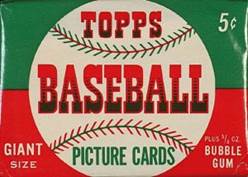
The battle was joined. Topps and Bowman fought to sign players, either to exclusive or non-exclusive contracts. Bowman had been paying players $100 per year, and Topps offered $125 for exclusive and $75 for non-exclusive. Willie had been on the 1951 Bowman card and elected to be non-exclusive in 1952, ending up on the sets of both companies.
Sy Berger was more than the clubhouse guy. He and Topps art director Woody Gelman changed the format of the card in 1952, and it became the prototype for future baseball cards. Berger: “Well, if you go back to the Bowman cards of 1948…they were black and white…they were small…We came out in 1952 with a card in color…and a card that was large…and for the first time we had a team logo. Also, we had the 1951 line statistics and their lifetime statistics.” Berger personally compiled the stats by working into the evening at his kitchen table – it’s not like you could just go to the internet in those days.
Below, some samples from 1952. The set was a home run, and Topps was on its way to the top (the name was no accident; it was meant to indicate that the company was to be “tops” in the chewing gum field).
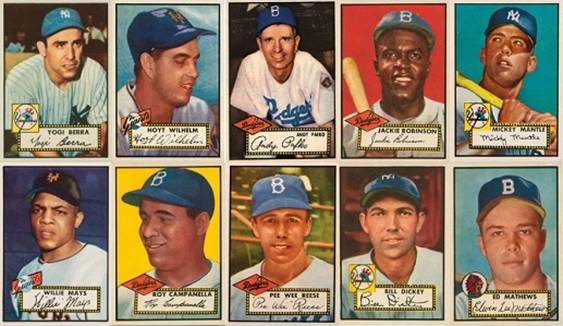
With the Korean War underway, Willie Mays was drafted and missed part of the 1952 season and all of 1953. Bowman elected to not do a Mays card for 1953, but Sy Berger wisely kept Willie in the loop.
The highly successful Topps cards in 1952 were colorized black-and-white photos. For 1953, Berger added some expense by using paintings of the players rather than photos. Berger: “We had a guy doing those paintings a mile a minute. A little off-the-wall guy name Moishe.” There were actually several artists, and they were paid $25 per card. The end result was a beautiful set of cards. The Willie Mays card is one of his most popular, even though he did not play that year.
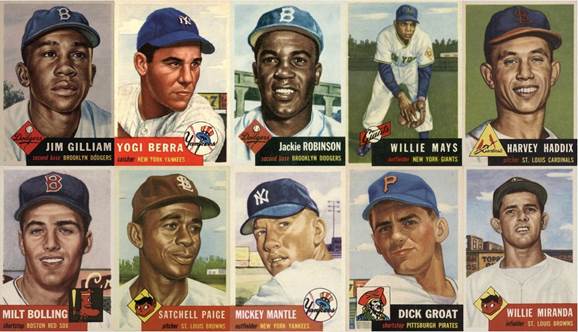
Willie returned to play in 1954 and had quite a year. He was the MVP and led the team to victory in the World Series where he made “The Catch.” What was good for Willie was good for Sy Berger who said, “And I was always in the clubhouse…this is New York. So, I was known as ‘Willie’s friend’ [They would say] ‘Well, you know, if it’s good enough for Willie, it’s good enough for me.’”
Below, on “Willie Mays Night” at Shea Stadium in 1973, Sy Berger presents Willie with a framed collection of his Topps cards.
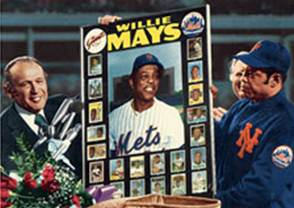
Sy Berger died in 2014 at the age of 91, and Willie Mays had this to say: “He was my long-time friend. He helped me from my first days in the majors. I never could have made it without him. He always knew the right thing to say or the right thing to do. We worked together. We laughed together. We grew up together…So long old pal.”
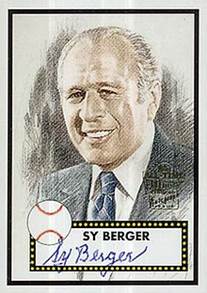
Satchel Paige and Sy Berger: Hot Stove #161 featured a story about how Joe Biden often uses a Satchel Paige quote when questioned about his age: “How old would you be if you didn’t know how old you are?”
After posting that Hot Stove, I ran across an audio version where Biden used his Satchel story in the context of Tom Brady playing in Super Bowl LV at age 43. Biden concluded that under Satchel’s test, Brady was 22 (not 43) and Biden was 45 (not 78). Click here (turn up the sound; 0:45).
This explains why President Biden has a Satchel Paige card in the Oval Office. Now let’s take a closer look. The card is from that 1953 set shown above – the one with paintings instead of photos. The Paige card is considered one of the best paintings from the set, capturing him as the wise 47-year-old vintage player for the St. Louis Browns. Too bad Topps misspelled his first name as “Satchell.”

So I think we can assume Sy Berger met up with Satchel to sign him to Topps. Probably in spring training or while the Browns were in New York to play at Yankee Stadium.
What we know for sure is that Sy Berger kept the original artwork that was used for the Satch’s card. In 2010, Berger consigned 117 original 1953 Topps paintings to an auction house. One of them was the 3- by 5-inch painting of Satch.
Six paintings were not in the auction. Topps had auctioned off six in 1989 – Roy Campanella ($16,500), Bob Feller ($33,000), Whitey Ford ($35,200), Jackie Robinson ($78,100), Willie Mays ($88,000) and Mickey Mantle ($110,000).
The hottest item in the 2010 auction was the painting of Satchel Paige. It sold for $58,750. Of the other 116 sold, the next highest price was Warren Spahn for $7,638.
The painting, shown below, again came up for auction in 2018 and sold for $45,000.

Over the years, the values of the cards have mirrored the auction prices for the paintings. The most valuable cards from 1953 are Mickey Mantle, Willie Mays, Jackie Robinson and Satchel Paige.
Below, Willie and Satchel at Willie’s induction to the Hall of Fame in 1979. Satch was inducted in 1971.
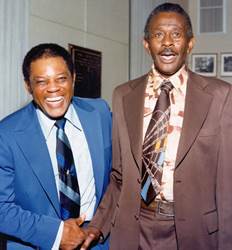
Bill Wakefield and Sy Berger: And now for loyal Hot Stove friend Bill Wakefield. To remind you, Bill is a native Kansas Citian who played six years of pro ball, including one season in the majors with the Mets (1964).
By 1964, Topps was the only major card game in town. Bowman had thrown in its cards (so to speak) by selling out to Topps in 1956. This no doubt made Sy Berger’s job of signing up players a little easier. But he was still a pro at his job.
Bill was originally signed by the Cardinals and went to their minor league camp in the spring of 1961. Like most of the new players, he took a $50 “signing bonus” from Topps, but it meant little at the time because most players didn’t get to the majors and end up in a Topps set. Bill also received $50 from Fleer which was trying to get a share of the market, but they would fade out.
Bill was traded to the Mets and went to their St. Petersburg spring training camp in 1964. That’s when he met Sy Berger. He has fond memories…
“Sy was a wonderful friend. Personable – charming – good guy – loved his job. Could work the clubhouse like a pro. He took care of me like a superstar. When I first met him at spring training in 1964, he said ‘Hey Billy, Mets cards are popular – sign here – three-year guarantee for you – we’ll make cards even if they send you down to the minors!!’ I was just happy to be there – ‘sure Sy, sounds good to me.’ He said when I first arrived at the Mets, ‘Hey Bill, let’s get you, Duke (Snider) and Casey (Stengel) together for a photo.’ Who me???? Casey from KC and the Duke who came over from the Dodgers to the Mets for a short time in ’64. I made the major league roster and saw Sy at Shea Stadium when Topps was taking photos on the field. He said ‘Get yourself a nice suit down at 44th and 8th Avenue. Next to the Manhattan Hotel. Across from the Peppermint lounge.’ ‘OK Sy, anything you say.’”
Berger often sweetened his deals with merchandise, such as a refrigerator or carpeting, or maybe a new suit. Bill got two Topps suits, and here he is sporting one of them:

Bill’s 1964 rookie card was shared with fellow pitcher Jerry Hinsley – two “1964 ROOKIE STARS.”
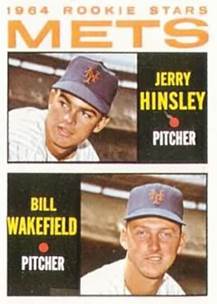
One quick anecdote from that 1964 season. When Willie Mays turned 90 earlier this month, Bill sent me an email:
“I’m in Willie’s home run book! Good sinker down and in. He inside-outed it. Strong! Shea Stadium right field!!”
I checked the record and found that Bill gave up this homer to Willie before 45,642 fans at Shea Stadium on August 5, 1964. It was Willie’s 31st homer of the season and #437 in his 660-homer career.
Bill had a good season in New York, appearing in 62 games (a Mets record at the time) and posting an ERA of 3.61. Below, Bill with Mets manager Casey Stengel.
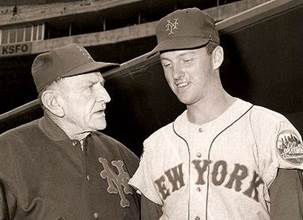
Bill went to spring training with the Mets in 1965, but did not make the major league roster. He of course might get called up, so as Sy Berger had assured him, he was in the 1965 Topps set (below). Alas, Bill did not get called up in 1965.
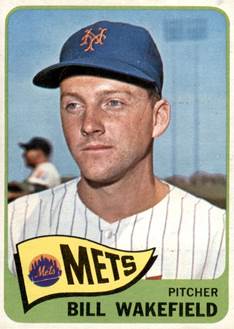
In 1966, as Yogi Berra might say, it was déjà vu all over again. Bill went to spring training. Was sent to the minors. Got the third-year baseball card that Sy Berger had promised (below). Was not called up to the majors.
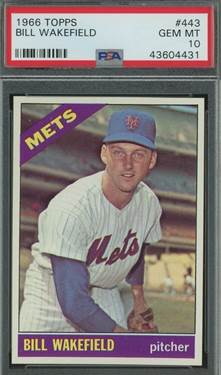
After 1966, Wakefield retired from baseball and resumed his studies at Stanford, after which he enjoyed a successful business career.
Although Bill has been out of baseball for 55 years, his baseball cards live on. Collectors love to have complete sets, and all three of Bill’s cards are still out there in the market. The prices generally range from a few dollars to over $100, depending on the condition (grading) of the card. Bill still gets 15-20 cards a month asking for an autograph. He gladly complies, knowing it increases the value for the owner.
In 2019, the 1966 card shown above hit the market. The card is high quality – note that the grading is GEM MT 10 (Gem Mint), the highest official grade. This makes the card relatively rare, and it was advertised on eBay as “SUPER ELUSIVE.” When the auction ended, Sy Berger’s third-year card for Bill Wakefield sold for $3,500.
1966 Postscript: Sy Berger was not the only person making the rounds of the clubhouses at spring training in 1966. Marvin Miller was meeting with the players to form a union. One of the first things Miller did was negotiate new deals with Topps that greatly increased payments to the players.
Bill Wakefield, Bob Dylan and Satchel Paige: Earlier this week (May 24), Bill Wakefield and Bob Dylan turned 80. I’ll get there in August.

What does that have to do with Satchel Paige? First, Wakefield and I are only 60 (“How old would you be…”).
As for Dylan, he is connected to Satchel through a 1967 documentary by D. A. Pennebaker. The filmmaker followed Dylan on his 1965 concert tour in England, and the resulting film was titled Dont Look Back (not a typo; the movie title did not have an apostrophe). Pennebaker said he titled the film as a homage to Satchel Paige who famously said “Don’t look back. Something might be gaining on you.”
Pennebaker felt that the quote captured Dylan, saying “To me, Satchel’s quote means if you’re a person who is driven to make artistic decisions you should never look back at them. You can only look ahead in your life, and I think that’s what Dylan has done…Dylan gets on with it, he never looks back, he always looks ahead. The artist should be looking ahead and into the unknown.”
Using baseball metaphors, one pundit said that Satch’s motto “nails Dylan’s paranoid style of American pop-stardom, which assumes that another hot young rookie is out there itching to take your place in the lineup and that only forward motion – in art, persona and relationships – can beat back the competition.”
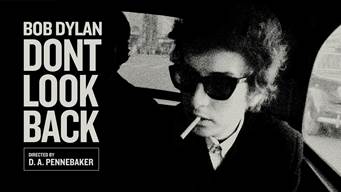
A big example of Dylan going forward, to the chagrin of many of his fans, was moving from acoustic to electric as his music transitioned from folk to rock. The New Yorker picked up on this for Dylan’s 80th birthday:

Dylan’s birthday also got some cartoon notoriety 50 years ago from Charles Schulz:

Lonnie’s Jukebox – Bill Wakefield Edition: I did not know Bill in his playing days. I met him about five years ago (via email) through our mutual friend Irv Blond who asked that I add Bill to the Hot Stove mailing list.
As often happens in our small town of Kansas City, Bill and I have a connection dating back to 1959, the year we graduated from high school. He went to Pem-Day and was a basketball star. I was at Van Horn, and, being slow and short, was the student manager of our basketball team. Van Horn had one of the best basketball players in the city – my friend since grade school, Jim Whipple (RIP). Jim was a few months older and served as a mentor to me through cub scouts, boy scouts (fellow Eagles) and 3&2 baseball. Jim was often the best pitcher and hitter on our 3&2 teams, although not in quite the same category as Wakefield who pitched back-to-back no-hitters in Ban Johnson play.
And here you go, Whipple and Wakefield on the all-district team in 1959.

Jim was also named all-state and was the recipient of the DiRenna Award Trophy given to the top high school basketball player in greater Kansas City.
Now I’ll move to some trivia to set up the selections for Lonnie’s Jukebox. In 1964, five years out of high school…
1. I finished up my master’s degree in engineering at Rolla and entered law school at UMKC.
2. Bill Wakefield pitched in the major leagues.
3. Bob Dylan released his album The Times They Are A-Changin’.
Two have a Wikipedia page.
To honor Bill’s year in the majors, the selections on Lonnie’s Jukebox today are hits from 1964.
“The Times They Are A-Changin’” by Bob Dylan. The title song from the album.
“Can’t Buy Me Love” by the Beatles. The Beatles hit the Top-40 in the US for the first time in 1964. The prolific Fab Four had 20 Top-40 hits that year, six going to #1.
[Sy Berger Trivia: Bill Wakefield and other ballplayers were not the only celebrities signed by Sy Berger in 1964. Topps also did non-sports trading cards (going back to Hopalong Cassidy). Because of Berger’s negotiating skills, Topps sent him to London to sign the hottest celebrity act of the year – the Beatles. Berger greeted their manager, Brian Epstein, in Yiddish and sealed the deal.]
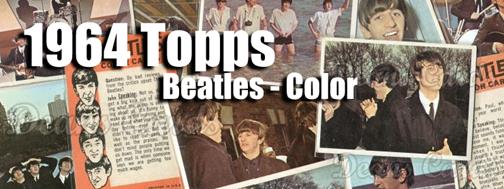
“Under the Boardwalk” by the Drifters.
“I Get Around” by the Beach Boys.
“Baby Love” by the Supremes. The second of five Supremes songs in a row to go to #1.
“Oh, Pretty Woman” by Roy Orbison. If you ask me, this song is about Rita.